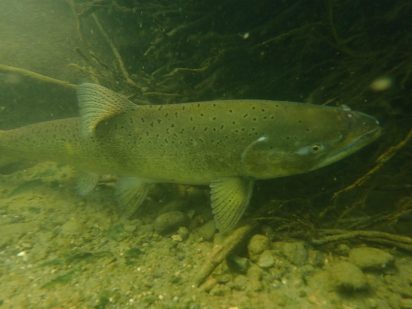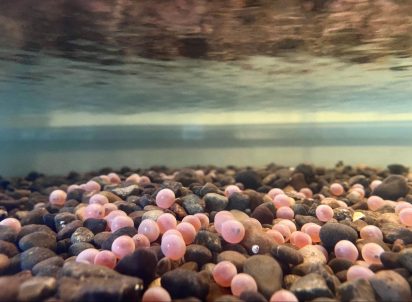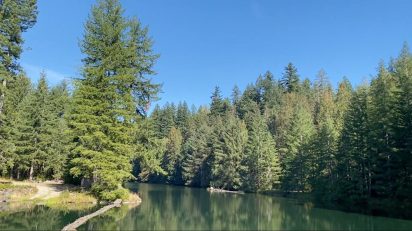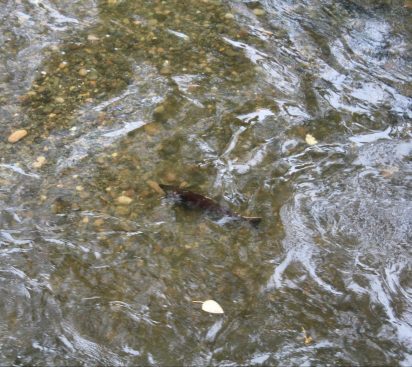A Reflection on Fall’s Delayed Rain
Come along on a salmon and naturalist’s journey through the Cedar River.
It’s been about three years since I was last home. I had an amazing time in the Salish Sea with my fellow Chinook salmon, but it is now time to return home to mate and give rise to the next generation. I recall the organic odor of my natal stream. I start to use my keen sense of smell and the earth’s magnetic field as my internal GPS to navigate back to the spawning grounds where I was born. As a female Chinook salmon, I am larger in size than other Pacific salmon species, weighing around ten pounds. To make my journey, I must transition from salty ocean water to purer freshwater through the fish ladder at the Ballard Locks and through the Lake Washington Ship Canal. It is an abrupt shift, but this is the only way home. I continued my journey into Lake Washington, but I could not sense the fresh, clear, cool water that I needed, so I waited around until the conditions were just right. I waited and waited. Now, I am so hungry. I have not eaten since I was last in the ocean about a month ago and my fat reserve is slim. The clock is ticking. It’s almost time to release my eggs. Why is the water unusually warm? Why is the water level lower than when I last came through? As I ponder these questions, I swim around and see that some of my Chinook salmon friends have passed. We came back to freshwater to spawn, not to die before doing so.
As I start to lose hope, I hear raindrops falling on the nearby trees and I feel them hit the water. Oh, thank goodness. I have missed that musky fresh smell and taste of fresh rain. I am weak, but I hold onto my last bit of hope and start swimming upstream towards my breeding grounds in the Cedar River watershed near Landsburg Reach Natural Area. I am so close and I must pass through the last hurdle of the Landsburg Dam Fish Ladder. I continue to swim against the water and leap my way up the ladder. After miles and miles of swimming upstream, I am home. I made it. I let out a sigh of relief. However, I cannot rest. I am running out of time. I search for a nice shaded area and begin to flip my caudal fin to clean the gravel and create a depression where my eggs will be buried, my redd. I lay about 3,000 eggs in batches and a male Chinook, bronze and red in color, comes just in time to release his milt. Now all I can do is hope that my baby salmon hatch, which can take roughly 50 days. I wish I could guard them and watch them emerge from the gravel as fry, but my time is coming to an end. I will pass in about one week and my carcass will wash down the river depositing nutrients back into the Cedar River watershed for native plants. It’s all a beautiful connected loop.


***
Born and raised in Honolulu, Hawaii, I grew up with 70 to 80 degrees Fahrenheit weather year round and was surrounded by blue skies. Moving to Seattle, Washington, I looked forward to experiencing seasons, particularly fall. My favorite fall weather is when the sun shines, and the air is cold and crisp, and there is a blend of red, orange, and yellow leaves. I dread rain and was happy to hear that this year’s rainfall was delayed. However, this happy feeling did not last for long.
For the past three years, I have been volunteering at the Seattle Aquarium as a habitat interpreter, engaging guests with stories about the many invertebrates, fishes, and mammals that reside at the aquarium. When I found out that the Cedar River Salmon Journey program staff were looking for new volunteers to help interpret along the Cedar River, I jumped at the opportunity. I had never seen a live salmon, let alone in the wild. I had also never seen a dam or salmon hatchery. I was excited to learn more about salmon and share my own excitement with the public. In October, I started working along the Cedar River at a few different sites, my favorite being the Landsburg Reach Natural Area. I learned so much about native plants, salmon hatcheries, and fish ladders while interpreting at this site. I also had great conversations with guests as I led tours within the municipal Cedar River Watershed, which is open to the public in October. Guests get to see the sockeye hatchery operated by the Washington Department of Fish and Wildlife where staff incubate sockeye salmon eggs and release fry back into the Cedar River so they can rear naturally in Lake Washington. Guests also have the opportunity to see the Landsburg Diversion Dam and learn about how both humans and salmon rely on the Cedar River Watershed.
“I normally see a lot more salmon upstream by this time. The stream looks about three feet lower than it was last October. The lack of fresh cold water must be delaying the salmon run. I hope the stress of waiting around does not increase pre-spawn mortality,” says a fellow volunteer naturalist. After this conversation, I was feeling really conflicted about my happiness of having so many sunny days. Guilt consumed me and my heart clenched.

The dam-regulated Chester Morse Lake north of the Cedar River collects mountain snowmelt and rainfall from the watershed and brings it into the river. Spanning across 90,000 acres, the Cedar River Watershed provides clean freshwater for many humans living in the greater Seattle area as well as salmon born in the river. Both juvenile salmon, known as fry, and adult salmon rely on cold water because it holds more dissolved oxygen than warm water. Cold water also regulates a salmon’s metabolism to balance the amount of food required to grow and remain active. This is vital for fry who are primarily feeding on plankton, small crustaceans, and insect larvae. A slower metabolism is also vital for adult salmon who have stopped eating a month or more ago from when they left the ocean. For these reasons, salmon congregate in “cold water refuges” of deep pools of water around 40 to 50 degrees Fahrenheit and seek out shaded areas within the river created by native plants in riparian habitats.
It is not news that climate change is ongoing and continues to impact both people and marine organisms, including salmon. Last year in 2021, Seattle experienced its wettest fall in 15 years. Yet, this year, in 2022, Seattle broke the all time record for the most consecutive dry days in November. This lack of rain has impacted the water levels in many Washington rivers including the Cedar River. The United States Geological Survey has a monitoring location near the Landsburg Reach Natural Area for tracking water discharge, gage height, and temperature. Looking at the data available for fall 2021 and fall 2022, we see that in 2021, the steady lower base flow around 1.70 feet was on October 10th, 2021. In comparison, this year, the steady lower base flow around 1.64 feet did not occur until November 11th, 2022 following the delayed fall rain. As the variability in river conditions continues with ongoing climate change, it is vital to understand the association with the timing and sensitivity of the salmon life cycle.

All Pacific salmon species are impacted by climate-induced stressors. However, the impacts these stressors have on already threatened species such as Chinook salmon are of great concern. Luckily, there are a few ways we can help reduce environmental stressors that salmon face as they return from the Salish Sea. Research shows that Chinook fry who are migrating out of degraded estuaries are less likely to survive. Thus, it is important for us to be mindful of our actions and how they impact salmon. Be sure to conserve water by installing water efficient appliances if possible. Additionally, reviewing your water bill is vital to recognizing your water use patterns and addressing any irregularities that may be caused by leaks. To help keep waterways clean, drop off your unused medications to community kiosk drop off sites rather than flushing them down the drain. Additionally, take toxic substances to proper disposal facilities and cover any spills with absorbent materials like sand. If you are a driver, do not forget to ensure that your car tires are properly inflated and aligned to reduce wear and carbon dioxide emissions.
Since moving to Seattle I have really enjoyed learning about salmon in the region, our local watersheds, and the ecological importance of rain. Pacific salmon including Chinook reside at the Seattle Aquarium, so I continue to share my knowledge with guests and share the ways they can help join the fight to conserve these iconic species. Now, knowing more about salmon ecology and their reliance on fresh cold water inputs, I will be smiling the next time it rains.